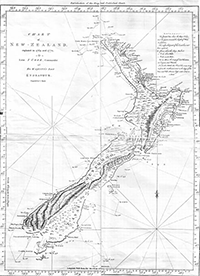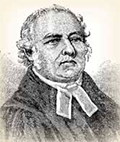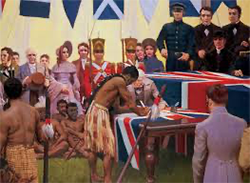The Establishment of Modern New Zealand
A treaty between representatives of Great Britain and Māori chieftains resulted in the foundation of the modern country of New Zealand in 1840. 
Dutch navigator Abel Tasman in 1642 was the first European to explore what became New Zealand, making some charts of various parts of the coastline but not landing. England's James Cook made landfall multiple times in the late 18th Century while also circumnavigating the country and making detailed maps (left). Many more English explorers and settlers, so much that a contingent of English people signed a treaty with a number of chiefs of tribes of the then-native people, the Māori, who had lived in the land that they referred to as Aotearoa for hundreds and hundreds of years. In 1769, the same year that Cook first arrived, a French contingent of explorers under François-Marie de Surville had made landfall. They did not stay or come back, however. 
The British missionary Samuel Marsden (right) is said to have introduced Christianity into New Zealand, in 1814, founding a mission in the Bay of Islands. Another important go-between connecting the British and Māori peoples was Samuel Lee, who worked with a Mā chief, Hongi Hika, to create a written language from the spoken-only Māaori language. Beginning in the 1820s, more and more British settlers arrived, establishing settlements at places like Kerikeri and Bluff. At this very early time in the modern development of the country came a fundamental disagreement regarding the relationship between people and the land. The Māori saw themselves as guardians or protectors of the land. The British saw themselves as owners of the land. Such a different concept fostered different interpretations of what was permissible or "right" to do with the land on which people lived. (This extended the waters just offshore as well.) Marsden and subsequent missionaries convinced many ā to embrace Christianity as a religion. Another prized contribution to the Māori culture was the musket, a weapon that the native people did not have. The various native tribes had fought one another off and on for many years, but the addition of a new weapon to the arsenal touched off a new round of conflict. 
In 1839, a group of British businessman led by Edward Gibbon Wakefield formed the New Zealand Company, with the goal of buying large amounts of land in Aotearoa and setting up permanent settlements there. Captain William Hobson sailed southward and, on Feb. 6, 1840, signed the Treaty of Waitangi, along with about 40 Maāri chiefs. British officials then made copies of the treaty and took it around the North and South Islands, Even at this stage, varying interpretations of the treaty existed. The British version, written in English, clearly gave the British Crown sovereignty over what they called New Zealand. The Māori version, however, assigns to the Crown the right of kawanatanga, which in English is closest to governorship, which isn't exactly sovereignty. A governor might rule over a people, but a governor doesn't own those people. Such was the verbal minefield in which the foundation of the country of New Zealand was formed. |
|
Social Studies for Kids
copyright 2002–2025
David White



 collecting signatures of other chiefs who had not signed the treaty originally.
collecting signatures of other chiefs who had not signed the treaty originally.
